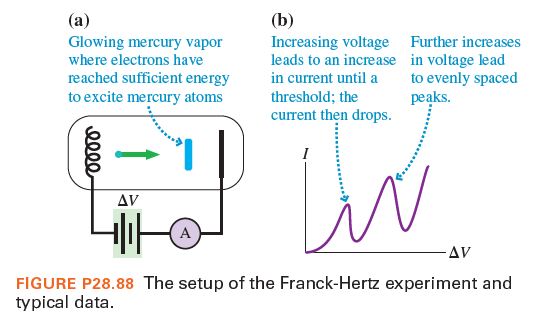(a) Glowing mercury vapor (b) Increasing voltage Further increases leads to an increase in voltage lead in current until a where electrons have reached sufficient energy to excite mercury atoms to evenly spaced peaks. threshold; the current then drops. Δν Δν FIGURE P28.88 The setup of the Franck-Hertz experiment and typical data. 2000
Atomic Spectra
According to the Bohr model of an atom, the electron in an atom moves around a nucleus in fixed orbits with specific energies known as energy levels. The orbital energies are quantized. The electrons remain in these energy levels until they emit or absorb a photon of a particular wavelength, the quantum of energy. If the electron emits a photon, it then falls back to a lower energy level, and if it absorbs a photon, the electron rises to higher energy levels. The photons released or absorbed in these transitions of an electron are studied and analyzed on a screen as atomic spectra.
Ruby Lasers
Lasers are devices that emit light using atoms or molecules at a certain wavelength and amplify the light to produce a narrow beam of radiation. It works as per the principle of electromagnetic radiation. Their source of emission contains the same frequency and same phase. It was invented in the year 1960 by the great noble scientist, Theodore Maiman.
Balmer Series
The spectrum of frequency observed when electromagnetic radiation is emitted from an atom when it goes from higher energy state to lower state, is known as emission spectrum. This transition occurs when an excited electron moves from higher to lower state. It has many possible electron transitions and each transition has a specific energy difference.
Emission Spectrum
Every state of matter tries to be at minimum potential energy or it can be said that the atoms of element/ substance arrange themselves such that overall energy is minimum.
Electrically excited mercury atoms have particularly strong emission of 4.9 eV photons, corresponding to a transition of one of the atom’s electrons from a higher energy state to a lower. Mercury vapor absorbs light of this wavelength as well; the energy of the photon moves an electron from the lower state to the higher.
It’s also possible to produce an excitation through other means. If an electron with a kinetic energy of 4.9 eV strikes a mercury atom, it can transfer energy, moving an electron in the mercury atom from the lower level to the higher. The electron loses kinetic energy in the process; this is an inelastic collision. Electrons with kinetic energies lower than this transition energy undergo elastic collisions, leaving their kinetic energy unchanged.
This was the idea behind the Franck-Hertz experiment, a classic experiment of early-20th-century physics. The basic setup is illustrated in Figure P28.88a. A tube is filled with mercury vapor. A heated electrode emits slow-moving electrons, and a variable power supply provides a voltage to accelerate the electrons toward a second electrode. The current varies as the voltage is changed, as shown in Figure P28.88b. As the voltage is increased, this initially leads to an increased current. At a certain point, the electrons have enough energy to excite the mercury atoms, and the collisions lead to a loss in the energy of the moving electrons and a reduction in current, a clear demonstration of the existence of quantized energy levels in the mercury atom.
In modern versions of this experiment performed in student laboratories, the onset of inelastic collisions that excite the mercury atoms leads to a visible glow in the tube. This is illustrated in Figure P28.88a. The position of the glowing gas shows the location in the tube where the accelerating electrons reach the proper energy.
If the electrons that lose energy to a mercury atom continue to accelerate, they can acquire enough kinetic energy to excite another atom, leading to a drop in current. At what voltage does the drop in current begin?
A. 4.9 V B. 7.4 V
C. 9.8 V D. 14.7 V

Trending now
This is a popular solution!
Step by step
Solved in 2 steps









